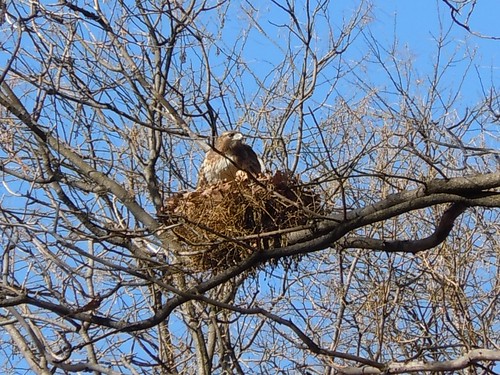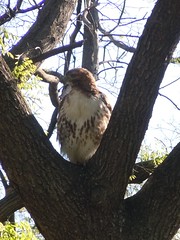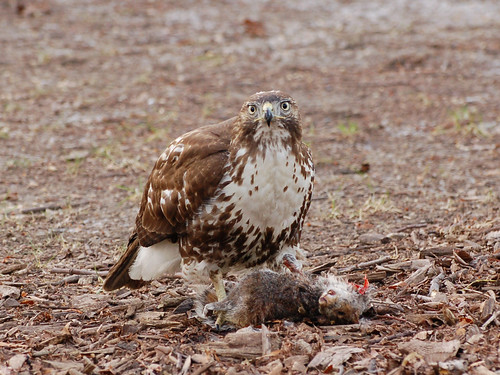 Carol Vinzant A red-tailed hawk in its nest in Tompkins Square Park earlier this year. Officials said that they stopped placing rat poison in the park to protect birds of prey, which feed on the rodents.
Carol Vinzant A red-tailed hawk in its nest in Tompkins Square Park earlier this year. Officials said that they stopped placing rat poison in the park to protect birds of prey, which feed on the rodents.Lately the hoards of rats scurrying all over Tompkins Square Park have disgusted local parents taking their children to the playground. Now, an ironic — and unwitting — culprit has emerged as the reason for the boom in rats: red-tailed hawks.
The Parks Department told The Local Monday that it stopped placing rat poison in the East Village’s green oasis in April because it could pose a danger to the feathered carnivores, which feed on the rodents.
“We are not placing rat poison in Tompkins Square because of the hawk,” said Philip Abramson, a spokesman for the Parks Department. “Instead we have replaced the garbage baskets with garbage drums, preventing rats from accessing its insides.”
The red-tailed hawk was first noticed this month on EV Grieve keeping vigil over the park, and occasionally feasting on a rat. Around the same time, a new parent group, Tompkins Square Park & Playgrounds Parents’ Association, sounded the alarm on the rats in The Villager, saying the critters were even burrowing in the sandbox.
As it turns out, the two occurrences are related. A poisoned rat can be a fatal feast for a hawk, especially a juvenile one.
“Accidental poisoning is the second-most common cause of death of birds in the city, after collisions with cars and buildings,” said Glenn Phillips, the director of New York City Audubon. “It is a big deal.”
Unfortunately, the hawk that prefers to perch in Tompkins Square simply does not have the capacity to devour all the rats there, no matter how big its appetite. In fact, there are only 25 to 30 red-tailed hawks in Manhattan, including ones that were born this year, according to Mr. Phillips.
“Red-tailed hawks are never going to be the answer to our rat control issue,” he said.
In 2007 a similar issue arose regarding poison laid in the park, but at that time the Parks Department did not rule out continuing to use the bait when hawks were spotted.
But this season the Parks Department has ceased using the poison and is instead attempting to eliminate rat havens.
“We also have removed ground cover in the park that had sheltered rats,” said Mr. Abramson. “We apply woodchips to the garden beds to expose rat burrows as well.”
Mr. Phillips said that the hawk was worth the trouble.
“We can go outside to any of our great parks in the city and these birds remind us that we are part of the natural world,” he said. “Nature is essential for our well-being.”





